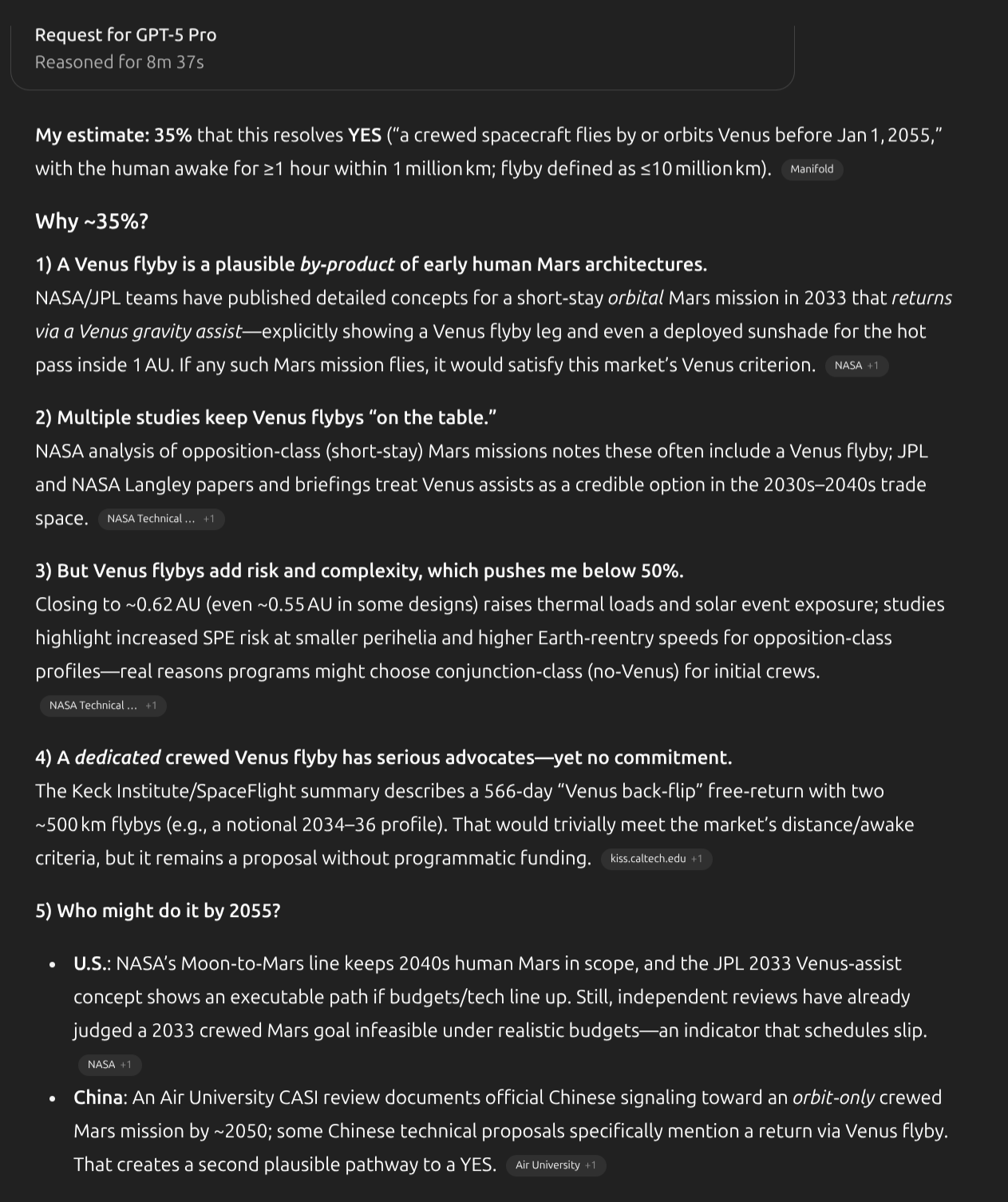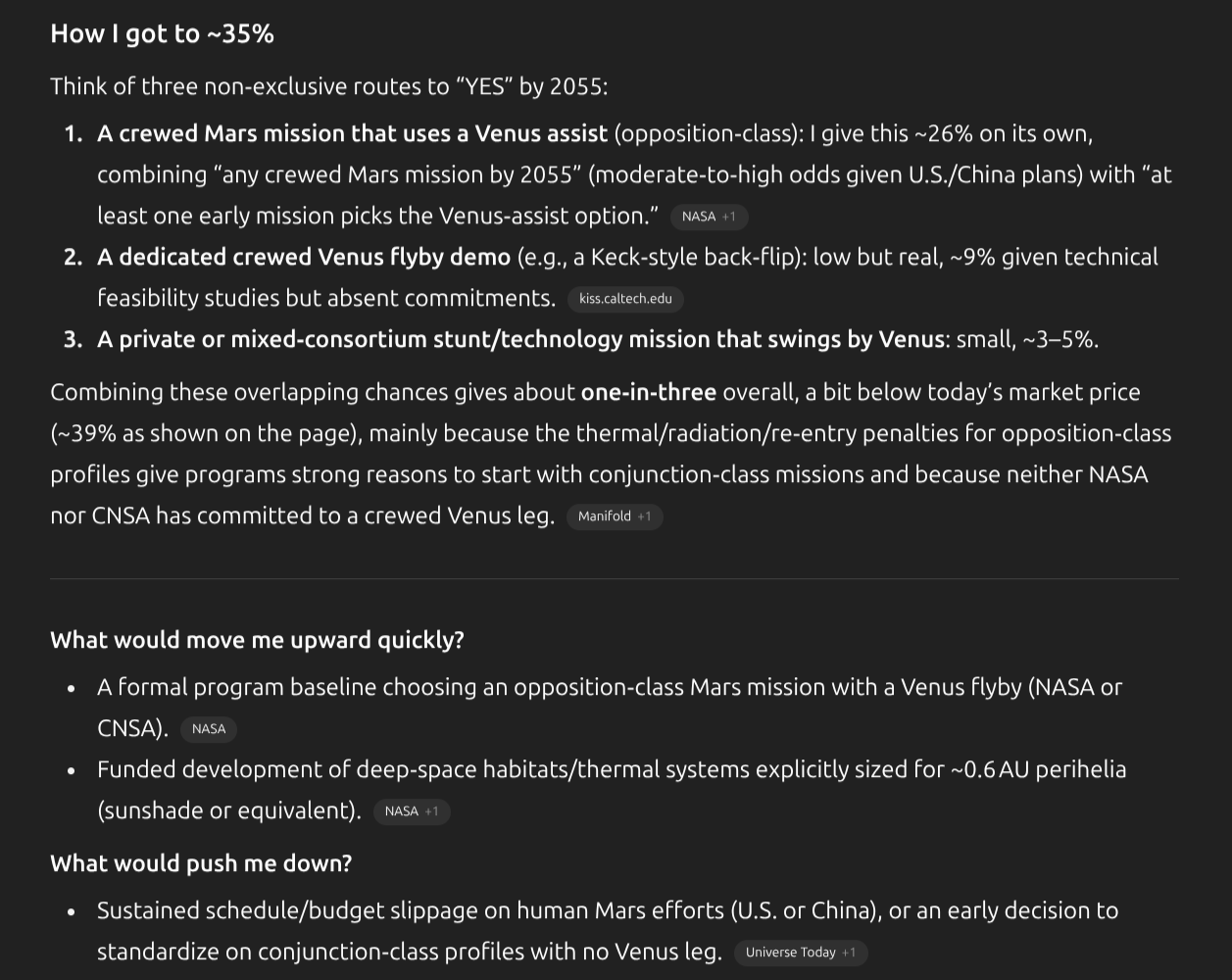
Resolves to YES if a spacecraft completes a flyby of Venus, or achieves orbital insertion, with at least one live human on board before January 1st, 2055. For the purpose of this market, a flyby of Venus must occur within a distance of no more than 10 million kilometers from the planet.
Questions with the same criteria:
/RemNiFHfMN/will-there-be-a-crewed-mission-to-v-91a92e57402f
/RemNiFHfMN/will-there-be-a-crewed-mission-to-v-4a5c4940b285
/RemNiFHfMN/will-there-be-a-manned-mission-to-v
/RemNiFHfMN/will-there-be-a-manned-mission-to-v-31e87dc6b88e
/RemNiFHfMN/will-there-be-a-manned-mission-to-v-4013a9a91e65
/RemNiFHfMN/will-there-be-a-manned-mission-to-v-6290eb11e91a
/RemNiFHfMN/will-there-be-a-manned-mission-to-v-9fc871c54493 (this question)
/RemNiFHfMN/will-there-be-a-manned-mission-to-v-c688003ecd21
/RemNiFHfMN/will-there-be-a-manned-mission-to-v-32b26fedf844
/RemNiFHfMN/will-there-be-a-crewed-mission-to-v
/RemNi/will-there-be-a-crewed-mission-to-v-4303809327f0
Human venture on Venus questions:
/RemNiFHfMN/will-a-human-venture-onto-the-surfa-cc226795c047
/RemNiFHfMN/will-a-human-venture-onto-the-surfa-f77ec20323dc
Solar system exploration questions:
/RemNiFHfMN/will-there-be-a-manned-mission-to-v-9fc871c54493 (this question)
/RemNiFHfMN/will-there-be-a-crewed-mission-to-m-0b9113192c85
/RemNiFHfMN/will-there-be-a-crewed-mission-to-j-dda395471570
/RemNiFHfMN/will-there-be-a-crewed-mission-to-s-63aadfa8bb2e
To meet the criteria, the human aboard the spacecraft must remain awake for at least one continuous hour during the period when the spacecraft is within the 1 million kilometers threshold from Venus. Furthermore, during this awake period, the human's heart rate must not drop below 30 beats per minute (prohibiting some, hypothetical, methods of stasis).
The safe return of the human passenger is not a necessary condition for the market to resolve to YES. The human must be alive as the spacecraft reaches the 1 million kilometers threshold from Venus. If the human is in a state of suspended animation or asleep at the time of crossing this threshold, they must be successfully resuscitated or woken up for at least one hour while the spacecraft remains under the specified distance from Venus.
Additionally, the human on board must possess both a functioning brain and heart, with limited alterations. These vital organs may have undergone chemical, mechanical, or electronic modifications, provided that these enhancements do not significantly alter the organ's functioning compared to that of a typical human. Complete modification or replacement of any other organ in the human's body is permissible within the context of this question.
Image credits: https://commons.wikimedia.org/wiki/File:PIA23791-Venus-NewlyProcessedView-20200608.jpg
People are also trading
https://arxiv.org/ftp/arxiv/papers/2006/2006.04900.pdf
It’s a thing. Not sure if it’s really viable though.
@RemNiFHfMN what are the benefits of a manned mission? Even if it's technically feasible I can't think of a good reason.
@GCS The answer is that there's probably going to be a period of some years where we have the physical equipment to do it (because of a Mars programme), and anything else we would do with said equipment would be harder, take longer and require other new tech to be developed.
This is why it was proposed for Apollo Applications Program. Obviously in that case they didn't do it, but then they didn't do anything else either
Hopefully reusable launch will bring down the cost of getting enough fuel into orbit such that it becomes attractive enough.
@GCS a Venus flyby could be a test run for a later outer planets mission, since these may include a Venus gravity assist
@JoshuaWilkes If someone else has already done a Mars flyby then the next best thing is a Venus flyby. It's a lot cheaper than setting up a Mars base. The prestige/cost tradeoff could make sense, depending on the agency's goals

